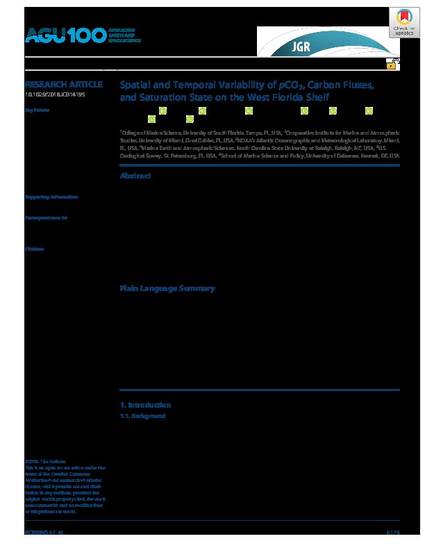
- West Florida Shelf,
- Gulf of Mexico,
- p CO2,
- carbon flux,
- saturation state,
- carbon budget
The West Florida Shelf (WFS) is a source of uncertainty for the Gulf of Mexico carbon budget. Data from the synthesis of approximately 135,000 p CO2 values from 97 cruises from the WFS show that the shelf waters fluctuate between being a weak source to a weak sink of carbon. Overall, the shelf acts as a weak source of CO2 at 0.32 ± 1.5 mol m−2 yr−1. Subregions, however, reveal slightly different trends, where surface waters associated with 40–200‐m isobath in the northern and southern WFS are generally weak sinks all year, except for summer when they act as sources of CO2. Conversely, nearshore waters ( < 40 m) are a source of CO2, particularly the southern shallow waters, which are a source all year round. The p CO2 of seawater has been increasing at a rate of approximately 4.37 μatm/year as compared to atmospheric p CO2 which has increased at a rate of about 1.7 μatm per year from 1996 to 2016. The annual CO2 flux has increased from −0.78 to 0.92 mol m−2 yr−1 on the shelf from 1996–2016. The WFS is emitting 9.23 Tg C/year, with the southern nearshore region emitting the most at 9.01 Tg C/year and the northern region acting as a sink of −1.96 Tg C/year. Aragonite saturation state on the WFS shows seasonal and geographic trends with values ranging from 2 to 5. Lowest values are found in winter associated with subregion < 40‐m isobath.
Journal of Geophysical Research: Oceans, v. 123, issue 9, p. 6174-6188
Available at: http://works.bepress.com/kendra_daly/91/

Data used in this article are available for download.
CTD and other environmental data for the northeastern Gulf of Mexico and west Florida shelf, July 2010 – May 2012.
CTD and other environmental data for the northeastern Gulf of Mexico and west Florida shelf: June 2012 – August 2014